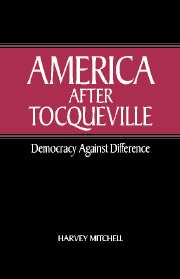Book contents
- Frontmatter
- Contents
- References to Tocqueville's Democracy in America
- Preface
- I PATHS TO DEMOCRACY IN AMERICA
- II BEGINNINGS AND DEMOCRACY
- III AMERICAN DEMOCRACY ON TRIAL
- 7 Difference, Race, and Color in America
- 8 Maintaining American Democracy
- 9 The State, Authority, and the People
- 10 Conclusion
- Works Cited
- Index
7 - Difference, Race, and Color in America
Published online by Cambridge University Press: 10 August 2009
- Frontmatter
- Contents
- References to Tocqueville's Democracy in America
- Preface
- I PATHS TO DEMOCRACY IN AMERICA
- II BEGINNINGS AND DEMOCRACY
- III AMERICAN DEMOCRACY ON TRIAL
- 7 Difference, Race, and Color in America
- 8 Maintaining American Democracy
- 9 The State, Authority, and the People
- 10 Conclusion
- Works Cited
- Index
Summary
The Indians will perish in the same isolated condition in which they have lived, but the destiny of the Negroes is in some measure interwoven with that of the Europeans. These two races are fastened to each other without intermingling; and they are alike unable to separate entirely or to combine.
We began as a nation not through the accidents of race or religion or geography … but when a group of men, some of them political philosophers, put down, upon we now recognize as being quite sacred papers, their conception of the nation which they intended to establish on these shores. They described, as we know, the obligations of the state to the citizen, of the citizen to the state; they committed themselves to certain ideas of justice, just as they committed us to a system which would guarantee all of its citizens equality of opportunity.
I need not describe the problems which have arisen from these beginnings. I need only remind you that the contradiction between these noble ideals and the actualities of our conduct generated guilt, an unease of spirit, from the very beginning.
America has long lived with the psychological scars inflicted by conflicts over color and race. The changing uses of the term “race” have exercised and occupied the minds of all Americans in the past, and do so to this day.
- Type
- Chapter
- Information
- America after TocquevilleDemocracy against Difference, pp. 185 - 212Publisher: Cambridge University PressPrint publication year: 2002



